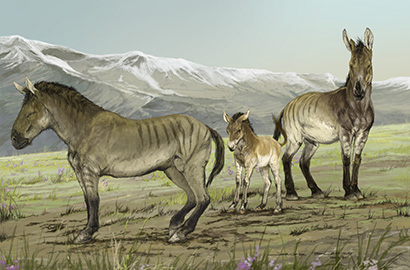Featured
A horse is a horse, of course, of course—except when it isn’t

By Tim Stephens
UC Santa Cruz
November 29, 2017 — Santa Cruz, CA
(Image above: A family of stilt-legged horses, Haringtonhippus francisci, in Yukon, Canada, during the last ice age is depicted in this illustration. Credit: Jorge Blanco)
Analysis of ancient DNA reveals a previously unrecognized genus of extinct horses that once roamed North America
An international team of researchers has discovered a previously unrecognized genus of extinct horses that roamed North America during the last ice age.
The new findings, published November 28 in the journal eLife, are based on an analysis of ancient DNA from fossils of the enigmatic “New World stilt-legged horse” excavated from sites such as Natural Trap Cave in Wyoming, Gypsum Cave in Nevada, and the Klondike goldfields of Canada’s Yukon Territory.
Prior to this study, these thin-limbed, lightly built horses were thought to be related to the Asiatic wild ass or onager, or simply a separate species within the genus Equus,which includes living horses, asses, and zebras. The new results, however, reveal that these horses were not closely related to any living population of horses.
Now named Haringtonhippus francisci, this extinct species of North American horse appears to have diverged from the main trunk of the family tree leading to Equus some 4 to 6 million years ago.
“The horse family, thanks to its rich and deep fossil record, has been a model system for understanding and teaching evolution. Now ancient DNA has rewritten the evolutionary history of this iconic group,” said first author Peter Heintzman, who led the study as a postdoctoral researcher at UC Santa Cruz.
Evolutionary distance
“The evolutionary distance between the extinct stilt-legged horses and all living horses took us by surprise, but it presented us with an exciting opportunity to name a new genus of horse,” said senior author Beth Shapiro, professor of ecology and evolutionary biology at UC Santa Cruz.
The team named the new horse after Richard Harington, emeritus curator of Quaternary Paleontology at the Canadian Museum of Nature in Ottawa. Harington, who was not involved in the study, spent his career studying the ice age fossils of Canada’s North and first described the stilt-legged horses in the early 1970s.
Continue reading article here: https://news.ucsc.edu/2017/11/ancient-horse.html
###




